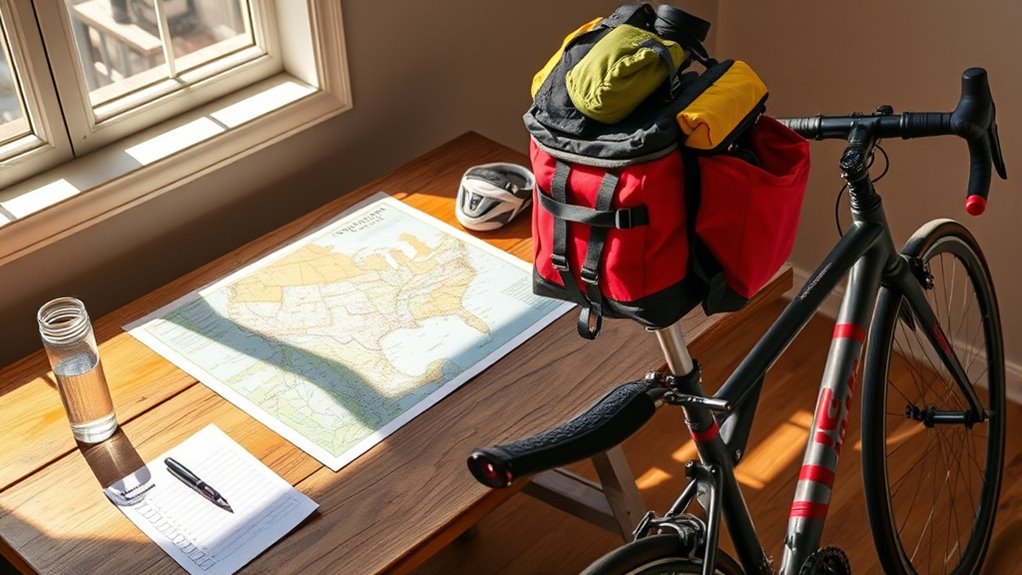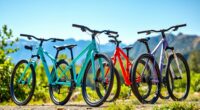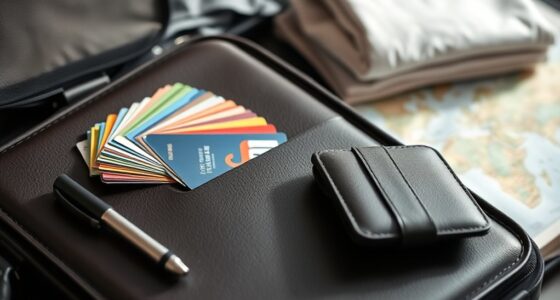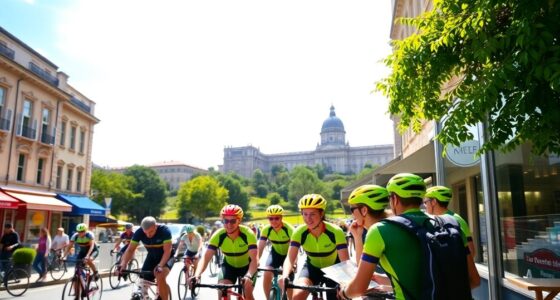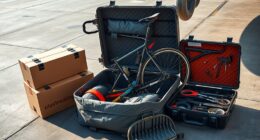To plan your first bike trip, carefully map your route, considering distance, scenery, and rest stops, while staying flexible for changes. Pack lightweight gear, including repair tools, weather-appropriate clothing, and essential safety items like a helmet and sunscreen. Organize your bike with panniers or backpacks for even weight distribution, and verify it’s in good condition. Share your plans with someone you trust and prepare for all conditions. If you continue exploring, you’ll find more tips to make your adventure smooth and enjoyable.
Key Takeaways
- Plan your route considering distance, scenery, terrain, and weather, with flexibility for adjustments.
- Pack lightweight, versatile gear including repair kits, appropriate clothing, safety equipment, and sleeping essentials.
- Organize bike gear using panniers or backpacks to distribute weight evenly and keep essentials accessible.
- Share your route and emergency contacts with someone trusted, and carry a charged phone and power bank.
- Practice riding with loaded gear to build confidence, and approach your trip with a positive, safety-conscious mindset.
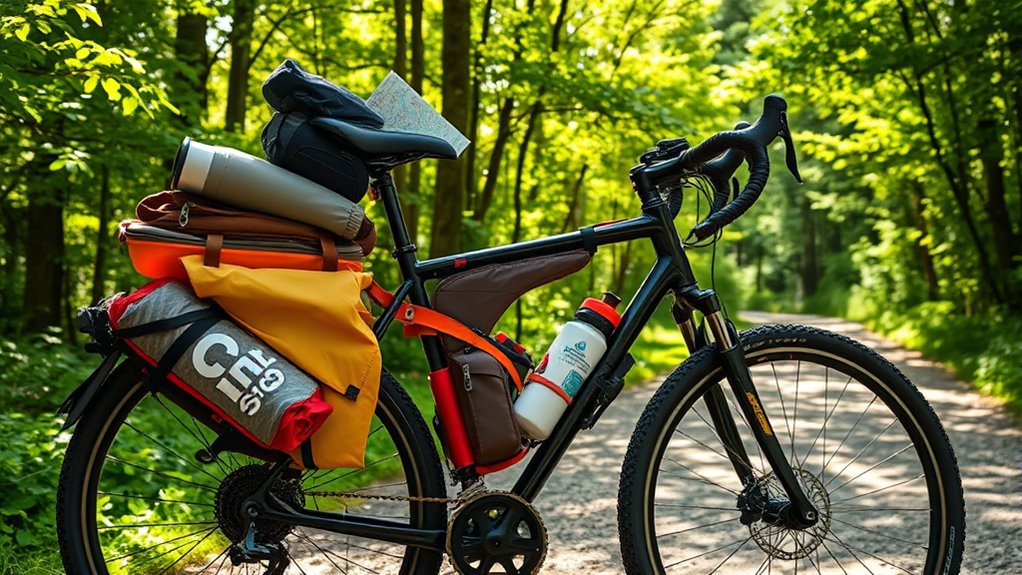
Have you ever wondered how to turn a simple bike ride into an unforgettable adventure? The secret lies in proper planning and packing. When you’re preparing for your first bike trip, start by mapping out your route carefully. Consider the distance you’re comfortable riding each day and look for scenic roads or dedicated bike paths that make the journey enjoyable. Check the terrain and weather forecast to guarantee your trip is safe and enjoyable. Planning ahead allows you to identify potential rest stops, water sources, and places to camp or stay overnight. It’s best to have a flexible plan, so you can adapt if conditions change or if you discover interesting spots along the way.
Plan your route carefully, considering distance, scenery, terrain, and weather for a safe, enjoyable cycling adventure.
Next, focus on packing efficiently. Your goal is to carry everything you need without overloading your bike, which can make riding uncomfortable or unsafe. Pack lightweight, multi-purpose gear that offers versatility. Essentials include a repair kit with spare tubes, a pump, and basic tools, along with a first aid kit. Clothing should be appropriate for the weather—think moisture-wicking layers, a waterproof jacket, and comfortable padded shorts. Don’t forget to bring a helmet, sunglasses, and sunscreen for protection. For sleeping, a compact sleeping bag and pad are worth their weight in comfort, especially if you plan to camp. Food and water are critical, so carry enough snacks and hydration bottles to sustain you between stops. A small stove or portable cookware can be handy if you want hot meals, but for shorter trips, simple snacks work fine.
Organization is key to a smooth trip. Use panniers, handlebar bags, or backpacks designed for cycling to distribute weight evenly. Keep your gear accessible—things like snacks, maps, or a camera should be within easy reach. Before leaving, double-check your bike’s condition—brakes, gears, tires—and guarantee you’re comfortable with your setup. Practice riding with your loaded bike, so you get a feel for the added weight and can identify any adjustments needed.
Finally, share your plans with someone you trust. Leave them with your route details and expected return time for safety. Pack a charged phone, power bank, and emergency contacts. Approach your first tour with enthusiasm but stay cautious. With thoughtful planning and smart packing, you set yourself up for a memorable journey—one where every pedal stroke takes you closer to new sights, new experiences, and a newfound confidence in your cycling adventure.
Frequently Asked Questions
How Do I Choose the Right Bike for Touring?
When choosing the right bike for touring, you should prioritize comfort, durability, and versatility. Look for a sturdy frame that fits your body well, preferably a touring or adventure bike designed for long distances. Consider features like multiple gears for varied terrains and rack mounts for carrying gear. Test ride different models to see what feels best, and think about your trip’s specific needs to make the best choice.
What Are Essential Safety Gear Items?
Imagine you’re in the wild west of cycling—your safety gear keeps you protected. You’ll want a well-fitted helmet, reflective clothing, and lights for visibility. Add gloves to prevent blisters, a first aid kit for emergencies, and a bell or horn to alert others. Don’t forget sunglasses and sunscreen for sun protection. These essentials keep you safe, confident, and ready to tackle any adventure on your bike trip.
How Do I Handle Bike Repairs on the Road?
When you need bike repairs on the road, stay calm and assess the issue quickly. Carry a basic repair kit with essentials like a multi-tool, spare tubes, tire levers, and a pump. If you’re unsure, find a safe spot to work and consult your kit’s instructions. For complex problems, consider calling for roadside assistance or fellow cyclists. Regular maintenance helps prevent surprises, but being prepared makes all the difference.
What’s the Best Way to Plan Daily Distances?
You want to crush your daily distances, right? Start by setting a realistic goal that matches your fitness level and terrain. Break your ride into manageable chunks, planning rest stops like clockwork. Use mapping apps to estimate distances, factoring in weather and terrain challenges. Be flexible—if a day’s too tough, don’t push; enjoy the journey instead of racing to the finish line. Keep your plans simple, and ride with confidence!
How Can I Stay Motivated During Long Rides?
Staying motivated during long rides can be tough, but you can keep your spirits high by setting small goals and celebrating each achievement. Remember why you started and visualize reaching your destination. Take regular breaks to refresh your mind and body, listen to your favorite music or podcasts, and connect with fellow cyclists if possible. Keep a positive attitude, and remind yourself that every pedal stroke gets you closer to your adventure’s end.
Conclusion
Remember, packing and planning are your bike trip’s compass and map. Just like setting out on a new adventure, I once underestimated how much to pack and ended up carrying extra weight that slowed me down. But once I streamlined my gear, everything felt lighter and more enjoyable. Think of your preparations as planting seeds for a smooth journey—when you’re well-prepared, each mile becomes a story worth telling. Happy touring!
